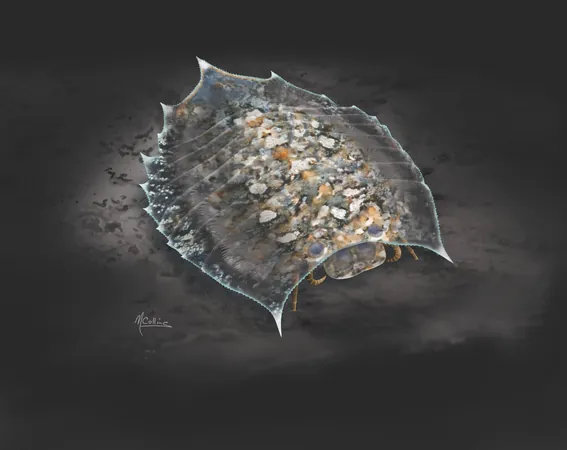
Groundbreaking Discovery of Ancient Arthropod Unravels 100-Year-Old Evolutionary Puzzle
2025-04-08
Author: Mei
Introduction
For over a century, the enigmatic Cambrian arthropod known as Helmetia expansa has puzzled scientists, remaining largely unclassified since its discovery by paleontologist Charles Doolittle Walcott in 1918. Initially believed to be a crustacean, this species never received a formal description nor did it have more than one specimen illustrated.
Recent Study
In a recent groundbreaking study published in the Journal of Systematic Palaeontology, a team of Harvard researchers spearheaded by postdoctoral fellow Sarah Losso has established a detailed account of Helmetia expansa, shedding new light on its anatomical structure, behavioral patterns, and its place in the evolutionary timeline of early arthropods.
Classification and Fossilization
Helmetia expansa is categorized within a rare group of early arthropods called concilitergans, relatives of the well-known trilobites. Unlike their trilobite cousins, who sported calcified exoskeletons, concilitergans had softer bodies that only fossilized in extraordinary conditions, such as those found in the 508-million-year-old Burgess Shale of Canada, where even delicate tissues like guts and gills have been preserved.
Although various specimens were collected, previous studies focused on just a single individual, leaving substantial gaps in understanding the species' full range of morphological characteristics and evolutionary significance. "We need to study more than one specimen to capture the species' complete morphology and preservation spectrum," remarked Losso.
Research Methodology
The research team meticulously examined 36 specimens housed at the Smithsonian Institution and the Royal Ontario Museum, utilizing advanced photographic techniques with a polarizing filter. This method enabled them to capture subtle anatomical details and even extinction phases, allowing comparisons with similar species from the Chengjiang biota in China and an early Cambrian specimen from Greenland's Sirius Passet.
Key Findings
One of the key findings was that Helmetia expansa possessed a unique leaf-like exoskeleton. Several specimens revealed remarkable preservation of eyes, digestive systems, and limbs. While it was previously thought that this arthropod lacked legs and relied solely on swimming, the researchers discovered well-developed gills and walking legs among various specimens, indicating that Helmetia likely employed a swimming and walking coordination akin to trilobites.
Even more astonishing was the observation of two specimens in the molt—a behavior that had never been previously documented in concilitergans. "Molting strategies have eluded researchers until now," Losso explained. "All arthropods undergo molting to grow, but capturing a specimen in the act is incredibly rare."
The specimens provided evidence of molting strategies where the new exoskeleton emerged from the front of the body, reminiscent of horseshoe crabs—who share this anterior exit strategy—as opposed to the more common posterior exit seen in most crabs.
Size Variation and Taxonomy
The researchers noted a fascinating variety in adult body sizes among Helmetia expansa specimens, with the smallest measuring just 92 millimeters, while larger individuals exceeded 180 millimeters in length. "These findings not only reveal growth patterns from 508 million years ago but also highlight the potential size range these ancient creatures could achieve," Losso stated.
Additionally, the study provided clarity on the taxonomy of helmetiid groups, confirming two main lineages: Helmediidae, characterized by defined segment boundaries and spines, and Tegopeltidae, which displays fused segments and no spines. The study also reclassified Arthroaspis bergstroemi, previously known from Greenland, into the concilitergan category.
Conclusion
"These new insights into the morphology and evolutionary relationships of Helmetia expansa enrich our understanding of concilitergans and other early arthropods, laying a strong foundation for future investigations," concluded Losso.
This remarkable study has taken a significant step toward unraveling the complexities of arthropod evolution, offering a clearer picture of life during the Cambrian period and highlighting the intricacies of one of Earth’s earliest ecosystems. Such discoveries serve as a powerful reminder of the fossil record's potential to unveil the mysteries of prehistoric life.




 Brasil (PT)
Brasil (PT)
 Canada (EN)
Canada (EN)
 Chile (ES)
Chile (ES)
 Česko (CS)
Česko (CS)
 대한민국 (KO)
대한민국 (KO)
 España (ES)
España (ES)
 France (FR)
France (FR)
 Hong Kong (EN)
Hong Kong (EN)
 Italia (IT)
Italia (IT)
 日本 (JA)
日本 (JA)
 Magyarország (HU)
Magyarország (HU)
 Norge (NO)
Norge (NO)
 Polska (PL)
Polska (PL)
 Schweiz (DE)
Schweiz (DE)
 Singapore (EN)
Singapore (EN)
 Sverige (SV)
Sverige (SV)
 Suomi (FI)
Suomi (FI)
 Türkiye (TR)
Türkiye (TR)
 الإمارات العربية المتحدة (AR)
الإمارات العربية المتحدة (AR)